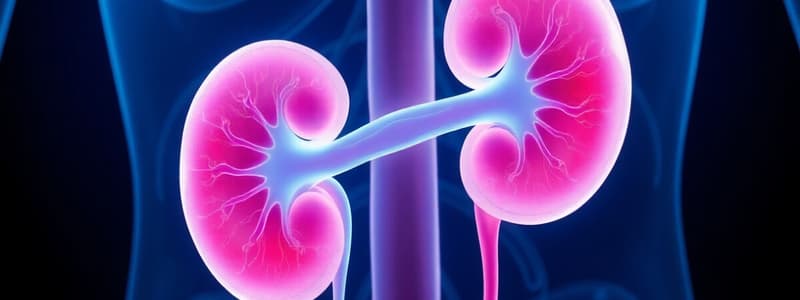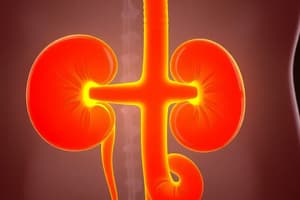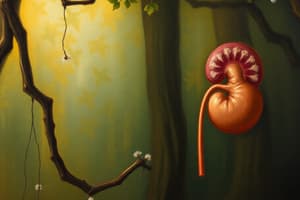Podcast
Questions and Answers
Which of the following substances are typically prevented from being filtered out of the blood at the glomerulus due to their size?
Which of the following substances are typically prevented from being filtered out of the blood at the glomerulus due to their size?
- Glucose
- Urea
- Sodium ions
- Proteins (correct)
A patient's blood test reveals a sodium level of 120 mEq/L. How will the kidneys typically respond to this condition?
A patient's blood test reveals a sodium level of 120 mEq/L. How will the kidneys typically respond to this condition?
- Increase sodium reabsorption and increase aldosterone release. (correct)
- Cease sodium reabsorption entirely.
- Reduce sodium reabsorption and decrease aldosterone release.
- Maintain normal sodium reabsorption with no change in aldosterone release.
What effect would a significant decrease in blood volume (BV) have on the glomerular filtration rate (GFR)?
What effect would a significant decrease in blood volume (BV) have on the glomerular filtration rate (GFR)?
- GFR would fluctuate erratically.
- GFR would decrease. (correct)
- GFR would increase.
- GFR would remain unchanged.
If a patient experiences a disorder causing excessive ADH (antidiuretic hormone) release, which of the following fluid shifts is most likely to occur?
If a patient experiences a disorder causing excessive ADH (antidiuretic hormone) release, which of the following fluid shifts is most likely to occur?
Which of the following best describes the process of tubular secretion in urine formation?
Which of the following best describes the process of tubular secretion in urine formation?
Which of the following scenarios would most likely result in the patient's extracellular fluid (ECF) becoming hypertonic?
Which of the following scenarios would most likely result in the patient's extracellular fluid (ECF) becoming hypertonic?
What is the primary function of the ureters?
What is the primary function of the ureters?
A patient experiences significant blood loss. How will this most likely affect the fluid distribution between their intracellular fluid (ICF) and extracellular fluid (ECF)?
A patient experiences significant blood loss. How will this most likely affect the fluid distribution between their intracellular fluid (ICF) and extracellular fluid (ECF)?
Which component of the digestive system is primarily responsible for water absorption and waste elimination?
Which component of the digestive system is primarily responsible for water absorption and waste elimination?
A patient is diagnosed with a condition that reduces bile production in the liver. What nutrient digestion will be most affected by this condition?
A patient is diagnosed with a condition that reduces bile production in the liver. What nutrient digestion will be most affected by this condition?
What is the role of mucus secreted by the stomach?
What is the role of mucus secreted by the stomach?
Which of the following is the correct order in which waste (chyme) passes through the regions of the large intestine?
Which of the following is the correct order in which waste (chyme) passes through the regions of the large intestine?
Which of the following processes occurs primarily in the small intestine?
Which of the following processes occurs primarily in the small intestine?
If a patient's liver is failing to adequately detoxify ammonia (NH3), which of the following complications is most likely to arise?
If a patient's liver is failing to adequately detoxify ammonia (NH3), which of the following complications is most likely to arise?
What is the glomerular filtration rate (GFR)?
What is the glomerular filtration rate (GFR)?
Which of the following best describes the composition of total body water (TBW)?
Which of the following best describes the composition of total body water (TBW)?
What is the primary function of albumin, a plasma protein produced by the liver, in relation to the digestive system and fluid balance?
What is the primary function of albumin, a plasma protein produced by the liver, in relation to the digestive system and fluid balance?
What is the role of the gallbladder in the digestive process?
What is the role of the gallbladder in the digestive process?
What digestive function is carried out in the esophagus?
What digestive function is carried out in the esophagus?
Approximately what portion of the cardiac output is normally received by the kidneys?
Approximately what portion of the cardiac output is normally received by the kidneys?
Flashcards
Kidney Function
Kidney Function
Produce urine, regulate blood volume and composition.
Ureters Function
Ureters Function
Drain urine from the kidneys to the bladder.
Urinary Bladder Function
Urinary Bladder Function
Collects and stores urine before it is released.
Urethra Function
Urethra Function
Signup and view all the flashcards
Urine Production Steps
Urine Production Steps
Signup and view all the flashcards
Glomerular Filtration
Glomerular Filtration
Signup and view all the flashcards
GFR (Glomerular Filtration Rate)
GFR (Glomerular Filtration Rate)
Signup and view all the flashcards
Tubular Reabsorption
Tubular Reabsorption
Signup and view all the flashcards
Tubular Secretion
Tubular Secretion
Signup and view all the flashcards
Osmosis
Osmosis
Signup and view all the flashcards
Mechanical Digestion
Mechanical Digestion
Signup and view all the flashcards
Chemical Digestion
Chemical Digestion
Signup and view all the flashcards
5 Main Parts of GI tract
5 Main Parts of GI tract
Signup and view all the flashcards
Esophagus Function
Esophagus Function
Signup and view all the flashcards
Stomach Function
Stomach Function
Signup and view all the flashcards
HCI/Hydrochloric Acid
HCI/Hydrochloric Acid
Signup and view all the flashcards
Liver Function
Liver Function
Signup and view all the flashcards
Stomach Bile
Stomach Bile
Signup and view all the flashcards
Gallbladder Function
Gallbladder Function
Signup and view all the flashcards
Pancreas Function
Pancreas Function
Signup and view all the flashcards
Study Notes
- The human body has two kidneys.
- Kidneys produce urine and regulate blood volume and composition.
- The human body has two ureters.
- Ureters drain urine from the kidneys.
- The urinary bladder collects and releases urine.
- The urethra drains the urinary bladder.
- Urine production involves glomerular filtration, tubular respiration, and tubular secretion.
- The glomerulus is a porous capillary bed acting as a strainer.
- Glomerulus filtration is the process of filtering blood at the glomerulus.
- Red blood cells (RBCs), white blood cells (WBCs), platelets, and proteins do not get filtered through the glomerulus because they are too large.
Glomerular Filtration
- Renal blood flow/perfusion drives the filtration process.
- Kidneys receive 1/4 of the heart's output.
- No blood flow to the kidneys results in no urine production.
- Blood volume influences blood flow.
- More blood flow leads to more filtration.
- Glomerular Filtration Rate (GFR) refers to the volume of filtrate produced by both kidneys per minute.
- Low blood volume (BV) or cardiac output (CO) decreases GFR.
- Low GFR decreases urine output (UO).
- High BV increases GFR, which in turn decreases BV.
Tubular Respiration
- Tubular respiration is the process where filtrate moves from the renal tube to the blood (peritubular capillaries), signifying substances to keep.
- The renal tube consists of Bowman's Capsule, proximal tubule, Loop of Henle, and distal tubule.
- The normal blood sodium (Na+) range is 135-145 mEq/L.
- A Na+ level of 140 results in normal filtration and reabsorption.
- A Na+ level of 150 results in filtration and less than normal reabsorption.
- A Na+ level of 120 results in filtration and more than normal reabsorption, along with aldosterone release.
Tubular Secretion
- Tubular secretion is the process where substances move from the blood (peritubular capillaries) to the filtrate (renal tube), signifying substances to lose.
Total Body Water
- Total Body Water (TBW) consists of 2/3 intracellular fluid (ICF) and 1/3 extracellular fluid (ECF).
- Extracellular fluid (ECF) consists of 80% interstitial fluid (between cells) and 20% plasma (bloodstream).
- Osmosis is the transfusion of water.
- The normal ECF & ICF concentration range is 280-300.
- Sodium (Na+) is the most abundant ECF solute.
- Water moving into a cell causes the cell to expand.
- Solvent is H2O.
- Solute is particles.
- High concentration occurs with normal solute and low solvent, or normal solvent and high solute.
- Low concentration occurs with normal solute and high solvent, or normal solvent and low solute.
- A concentration level of 300 is called hypertonic/hyperosmolar, indicating a concentrated state (low H20, high solute).
- Concentration levels refer to sodium (Na+) levels.
- Drinking lots of water dilutes the ECF, making it hypotonic.
- Eating salty food raises ECF concentration, making it hypertonic.
- In a traumatic brain injury (TBI), water moves out of the ECF and into brain cells (ICF) due to brain swelling, causing the ECF to become hypertonic/concentrated.
- Too much ADH release causes a hypotonic state, fluid shift from ECF to ICF, and cell expansion.
- Mild to moderate blood loss results in an isotonic state with no fluid shift, only a decrease in blood volume.
Digestive System
- The digestive system enables the body to take, breakdown, and absorb nutrients into the bloodstream.
- Mechanical digestion occurs in the mouth, where teeth cut, grind, and tear food.
- Chemical digestion occurs in the mouth, stomach, and small intestine.
- Food travels directly through the GI tract.
- The 5 main parts of the GI tract are the esophagus, stomach, small intestine, large intestine, and anus.
- The esophagus is a muscular tube that transfers food from the pharynx to the stomach; no digestion happens here.
- The stomach "liquifies" food into chyme for amino acid absorption, with chemical digestion occurring via secreted chemicals.
- Gastric refers to the stomach.
- The stomach secretes hydrochloric acid and mucus.
- Hydrochloric acid aids in chemical digestion to break down proteins, lipids, carbs, etc.
- Mucus coats the stomach lining to protect it from hydrochloric acid.
- Stomach ulcers result from insufficient mucus protection against hydrochloric acid.
- The small intestine is 18-20 feet long, where liquids travel through for amino acid absorption.
- The 3 parts of the small intestine are the duodenum, jejunum, and ileum.
- The duodenum is the first part of the small intestine where the stomach empties into; minimal chemical digestion happens here.
- The ileum is the last part of the small intestine that empties "formed" material into the large intestine.
- The large intestine absorbs water from waste as it travels through
- The large intestine consists of the cecum, ascending colon, right colic flexure/hepatic flexure, transverse colon, left colic flexure/splenic flexure, descending colon, sigmoid colon, and rectum.
- Accessory organs (liver, gallbladder, pancreas) contribute to digestion, but food does not pass through them directly.
- The liver produces bile, blood clotting factors, plasma proteins, and detoxifies NH3.
- Liver bile helps digest and absorb lipids; without bile, no lipids are absorbed.
- Hepatic refers to the liver.
- Albumin is the main plasma protein relevant to the digestive system, aiding in water retention.
- NH3 is ammonia.
- The gallbladder stores, collects, and releases bile into the duodenum.
- The pancreas has acinar cells that produce digestive enzymes for chemical digestion in the duodenum.
Studying That Suits You
Use AI to generate personalized quizzes and flashcards to suit your learning preferences.



